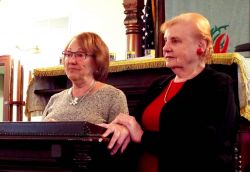PHOTO: Mitch Siegel lights candles in remembrance of the six million Jews who were killed during the Holocaust.
BY AMY FUHRMAN
Six candles flickered on the altar at Congregation Emanuel on Sunday — one for every million Jews killed during the Holocaust.
“They were all part of the Jewish people, each one suffered, each and every one murdered … their light extinguished,” Mitch Siegel told those gathered at the Statesville synagogue for Holocaust Remembrance Day. “We must remember them as 6 million individual tragedies.”
Shelly Weiner and her cousin, Rachel Kizhmerman, have been sharing their story of surviving the Holocaust and the unimaginable horrors they experienced as numerous members of their families were killed in hopes of educating the next generation about the Holocaust.
When Shelly was 4 and Rachel was 5, on Nov. 6, 1941, thousands in their Ukraine village were ordered to evacuate and assemble in a square. Fathers carried the family’s most valuable possessions, mothers carried young children and the healthy carried those who were sick. Rumor spread that they were all going to be deported.
Soon, it became apparent that there was no avenue for escape and that deportation was not the goal of the SS, Gestapo and Ukraine police.

Shelly Weiner and Rachel Kizhmerman shared their story on Sunday at Congregation Emanuel in Statesville.
“We understood we were walking to our own death. There was a ditch 100 meters long. The guns sounded and people fell into the pit like ears of corn. Some threw young children into the pit alive and others threw them into the air and shot them in flight,” Shelly read from an eye-witness account of a survivor of that day.
In all, 17,500 Jews were killed over the span of five days. Shelley and her mother had fled rather than follow the evacuation order, a decision that likely saved their lives.
In their film “Return to Rivne” through centropa.org, Shelly and Rachel describe the next two years of their lives, spent with their mothers in hiding from the Nazis.
The four spent more than 20 months hiding in a barn in Rovno, Ukraine, behind piles of straw with just enough room to sit and lay down. A family who lived on the farm helped them hide, and would bring them food. During that time, they were constantly plagued by rats, mice and lice. To entertain themselves, they would build dolls and animals out of straw and their mothers would tell them stories.
Then, their hiding place was discovered and the farmer warned them the Nazis were coming for them. Instead of going quietly, the four ran out the back of the barn and hid in a field for days, until the farmer was able to once again hid them, this time in an underground bunker.
“It was a dark, damp place. We were laying on straw and there were rats and mice in the thousands running around,” Rachel recalled in the film of the place they would live for months.
Finally, the war came to an end, and Shelly and her mother were reunited with her father, who had managed to survive. The family lived for more than three years in a German camp for “people without a country.” In 1949 — on Columbus Day — they moved to America, where they began a new life.
Rachel and her mother remained behind the Iron Curtain until 1980, when they moved with their family to the United States.
In 2013, the cousins returned to the site where they were hidden for so long, finding it largely untouched from the way it was left in 1945. The couple that hid them had passed away, but they were able to connect with their grandson.
“I have often wondered how the family had such strength and bravery to hide us when they knew the punishment would be death,” Shelly said. “They were extremely brave and caring.”
Shelley returned to Ukraine in 2015, and worked with educators there to begin teaching youth about the history of what happened during the Holocaust. Those efforts are very necessary, Rachel said, as the Holocaust is often an off-limits topic.
“I knew nothing about the Holocaust,” Rachel said. “In Russia, it was a subject no one could talk about. I really learned about it when I came to the United States as an adult.”
For Shelly, the process of sharing her story began close to home, when her daughter came home and showed her there was only one paragraph about the Holocaust in her text book. She asked her mother to come and speak to the class about her experiences. Other teachers heard, and “that’s how I started telling my story,” she said.
Hers and other stories of Holocaust survivors are extremely important today, to ensure that history is remembered and not repeated — especially as some people attempt to deny the Holocaust occurred.
“This will show young people that it did happen and it must never happen again,” she said.

